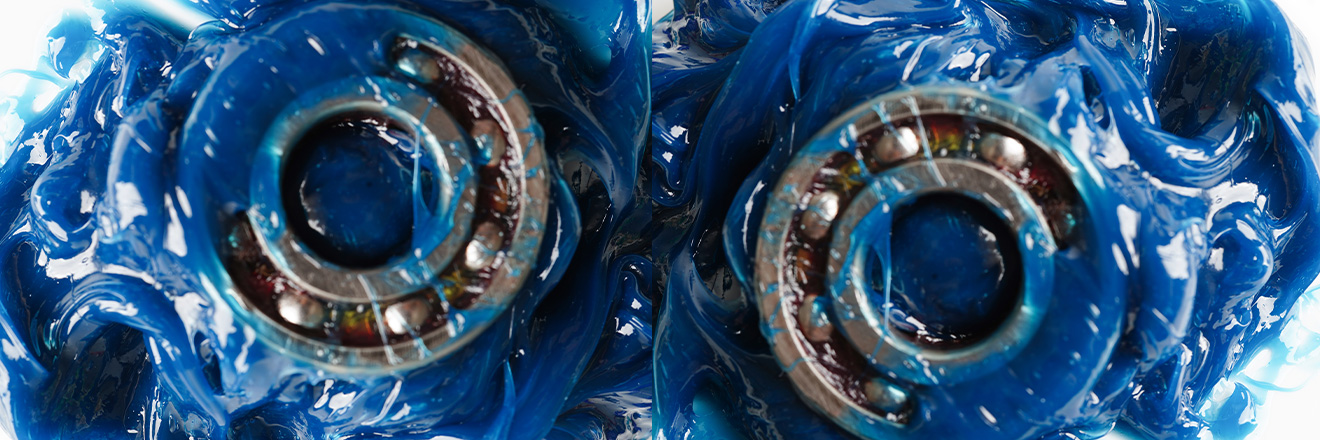When it comes to proper bearing lubrication, selecting the right grease is only half the battle-you must also apply the right lubricant amount at the right time. When you grab the grease gun to tend to a bearing, more grease is not always the better option and can be a costly mistake. Although common practice, applying grease until it purges out the seals does not keep a machine running optimally for longer. Too much grease can lead to high operating temperatures, blown seals and in the case of greased electric motors, energy loss and failures. The best ways to avoid these problems are to establish correct regrease intervals and amounts through calculations and the use of feedback instruments.
Churning
Too much grease volume in a bearing cavity will cause the rotating bearing elements to begin churning the grease. Churning can be compared to walking along the beach. If you reach ankle-deep water, it is easy to move (equivalent to running torque). However, if the tide comes in or you venture out into deeper water, it becomes much more difficult to walk. This requires you to work harder and causes you to tire out quicker. This is where lubricant churning can become an issue, resulting in energy loss and rising temperatures. Rising temps lead to rapid oxidation (chemical degradation) of the grease as well as an accelerated rate of oil bleed, which is a separation of the oil from the thickener.
The heat that has been generated over time along with the oil bleed eventually will cook the grease thickener into a hard, crusty build-up that can impair proper lubrication and even block new grease from reaching the core of the bearing. This can result in accelerated wear of the rolling elements and then component failure.
Seal Damage
Overgreasing can also result in seal damage. Grease guns can produce up to 15,000 psi, and when you overgrease a bearing housing, the lip seals can rupture, allowing contaminants to gain access into the bearing housing.
This excessive pressure can also damage single and double-shielded bearings, causing the shields facing the grease supply to collapse into the bearing race and leading to wear and eventually failure. When too much pressure is generated from a grease gun due to overgreasing, it is easy for the hard, crusty grease formed from heat (high operating temperatures) to be broken apart and sent directly into the bearing track.
Prevention
Refining your maintenance program is key to solving the problem of overgreasing. Each lube point, whether it be a bearing housing or electric motor, should be tracked as an asset, and records kept for scheduling planned maintenance or inspections of the asset. While the initial setup of a maintenance system and learning grease basics may take some time and hard work, the end results will have a major impact.
Calculate Lubrication Volume
Once you have planned the scheduling of the assets, you will need to determine the timing and amount of grease (volume) that should be applied at each point. The volume can be calculated with a simple equation (ref. SKF):
G = 0.114 x D x B
Where G = the amount of grease in ounces
D = the outside diameter of the bearing in inches
B = the bearing width in inches
Next, calibrate all grease guns in use and train the technicians on the proper procedures of usage. Calibrating a grease gun is very simple. All you need are the grease gun and a postal scale. Determining the weight in ounces per full stroke (shot) of the grease gun will allow you to identify the number of shots it takes to equal 1 ounce of grease. This will help you establish the right volume needed to ensure you are delivering the precise amount at each use.
Establish Regrease Frequency
After you have determined the correct volume, it's time to establish the proper frequency. There are several methods for estimating a regreasing frequency, including multiple calculators, tables and charts. Use our handy regreasing volume and frequency calculator for help. The major factors in determining frequency are load, operation time, type of bearing, speed, temperature and environment.
Feedback tools can also be beneficial for fine-tuning your frequency. For example, ultrasonic instrumentation is one of the best ways to optimize the correct frequency and help you set up your maintenance program.
Establishing appropriate procedures and inspections during relubrication is another important part of a maintenance program. Some basic steps include:
- Cleaning areas around the fill and relief fittings.
- Ensuring the grease relief valve moves freely or the drain plug is removed.
- Checking to be sure the relief passage is clean from any hardened grease that may be blocking grease from exiting.
- Greasing the bearing cavity with the correct calculated volume of grease while slowly adding each shot to minimize excessive pressure build-up.
- Depending on the recommendation of the OEM and if it can be safely done, the motor may be run during and after greasing to expel any excess grease. This should be done before re-installing the purge port or bottom grease relief valve and cleaning the area of any excess grease.
Extra Tips to Control Overgreasing
- Discontinue greasing when you feel abnormal back pressure.
- Always make sure relief ports are cleaned out from any debris or old, hard crust that could be blocking the passageway.
- Consider installing grease guns with pressure gauges, shut-off grease fittings or relief-type vent plugs.
- Slowly pump grease into bearings every few seconds. Using a quick-lever action could cause seal damage and not allow the grease to distribute throughout the bearing correctly.
